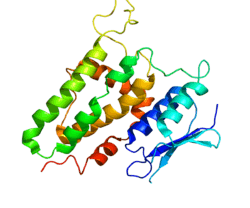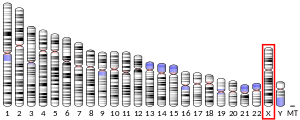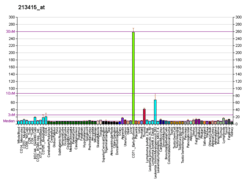CLIC2
Chloride intracellular channel protein 2 is a protein that in humans is encoded by the CLIC2 gene.[3][4]
Chloride channels are a diverse group of proteins that regulate fundamental cellular processes including stabilization of cell membrane potential, transepithelial transport, maintenance of intracellular pH, and regulation of cell volume. Chloride intracellular channel 2 is a member of the p64 family; the protein is detected in fetal liver and adult skeletal muscle tissue. This gene maps to the candidate region on chromosome X for incontinentia pigmenti.[4]
See also
References
- GRCh38: Ensembl release 89: ENSG00000155962 - Ensembl, May 2017
- "Human PubMed Reference:". National Center for Biotechnology Information, U.S. National Library of Medicine.
- Heiss NS, Poustka A (Nov 1997). "Genomic structure of a novel chloride channel gene, CLIC2, in Xq28". Genomics. 45 (1): 224–8. doi:10.1006/geno.1997.4922. PMID 9339381.
- "Entrez Gene: CLIC2 chloride intracellular channel 2".
Further reading
- Thiemann A, Gründer S, Pusch M, Jentsch TJ (1992). "A chloride channel widely expressed in epithelial and non-epithelial cells". Nature. 356 (6364): 57–60. doi:10.1038/356057a0. PMID 1311421.
- Rogner UC, Heiss NS, Kioschis P, et al. (1997). "Transcriptional analysis of the candidate region for incontinentia pigmenti (IP2) in Xq28". Genome Res. 6 (10): 922–34. doi:10.1101/gr.6.10.922. PMID 8908511.
- Singh H (2010). "Two decades with dimorphic Chloride Intracellular Channels (CLICs)". FEBS Letters. 584 (10): 2112–21. doi:10.1016/j.febslet.2010.03.013. PMID 20226783.
- Hartley JL, Temple GF, Brasch MA (2001). "DNA Cloning Using In Vitro Site-Specific Recombination". Genome Res. 10 (11): 1788–95. doi:10.1101/gr.143000. PMC 310948. PMID 11076863.
- Simpson JC, Wellenreuther R, Poustka A, et al. (2001). "Systematic subcellular localization of novel proteins identified by large-scale cDNA sequencing". EMBO Rep. 1 (3): 287–92. doi:10.1093/embo-reports/kvd058. PMC 1083732. PMID 11256614.
- Strausberg RL, Feingold EA, Grouse LH, et al. (2003). "Generation and initial analysis of more than 15,000 full-length human and mouse cDNA sequences". Proc. Natl. Acad. Sci. U.S.A. 99 (26): 16899–903. doi:10.1073/pnas.242603899. PMC 139241. PMID 12477932.
- Dhani SU, Mohammad-Panah R, Ahmed N, et al. (2003). "Evidence for a functional interaction between the ClC-2 chloride channel and the retrograde motor dynein complex". J. Biol. Chem. 278 (18): 16262–70. doi:10.1074/jbc.M209828200. PMID 12601004.
- Fan L, Yu W, Zhu X (2003). "Interaction of Sedlin with chloride intracellular channel proteins". FEBS Lett. 540 (1–3): 77–80. doi:10.1016/S0014-5793(03)00228-X. PMID 12681486.
- Board PG, Coggan M, Watson S, et al. (2005). "CLIC-2 modulates cardiac ryanodine receptor Ca2+ release channels". Int. J. Biochem. Cell Biol. 36 (8): 1599–612. doi:10.1016/j.biocel.2004.01.026. PMID 15147738.
- Gerhard DS, Wagner L, Feingold EA, et al. (2004). "The Status, Quality, and Expansion of the NIH Full-Length cDNA Project: The Mammalian Gene Collection (MGC)". Genome Res. 14 (10B): 2121–7. doi:10.1101/gr.2596504. PMC 528928. PMID 15489334.
- Wiemann S, Arlt D, Huber W, et al. (2004). "From ORFeome to Biology: A Functional Genomics Pipeline". Genome Res. 14 (10B): 2136–44. doi:10.1101/gr.2576704. PMC 528930. PMID 15489336.
- Ross MT, Grafham DV, Coffey AJ, et al. (2005). "The DNA sequence of the human X chromosome". Nature. 434 (7031): 325–37. doi:10.1038/nature03440. PMC 2665286. PMID 15772651.
- Bruneel A, Labas V, Mailloux A, et al. (2006). "Proteomics of human umbilical vein endothelial cells applied to etoposide-induced apoptosis". Proteomics. 5 (15): 3876–84. doi:10.1002/pmic.200401239. PMID 16130169.
- Mehrle A, Rosenfelder H, Schupp I, et al. (2006). "The LIFEdb database in 2006". Nucleic Acids Res. 34 (Database issue): D415–8. doi:10.1093/nar/gkj139. PMC 1347501. PMID 16381901.
External links
- CLIC2+protein,+human at the US National Library of Medicine Medical Subject Headings (MeSH)
- Human CLIC2 genome location and CLIC2 gene details page in the UCSC Genome Browser.
This article incorporates text from the United States National Library of Medicine, which is in the public domain.
This article is issued from Wikipedia. The text is licensed under Creative Commons - Attribution - Sharealike. Additional terms may apply for the media files.



